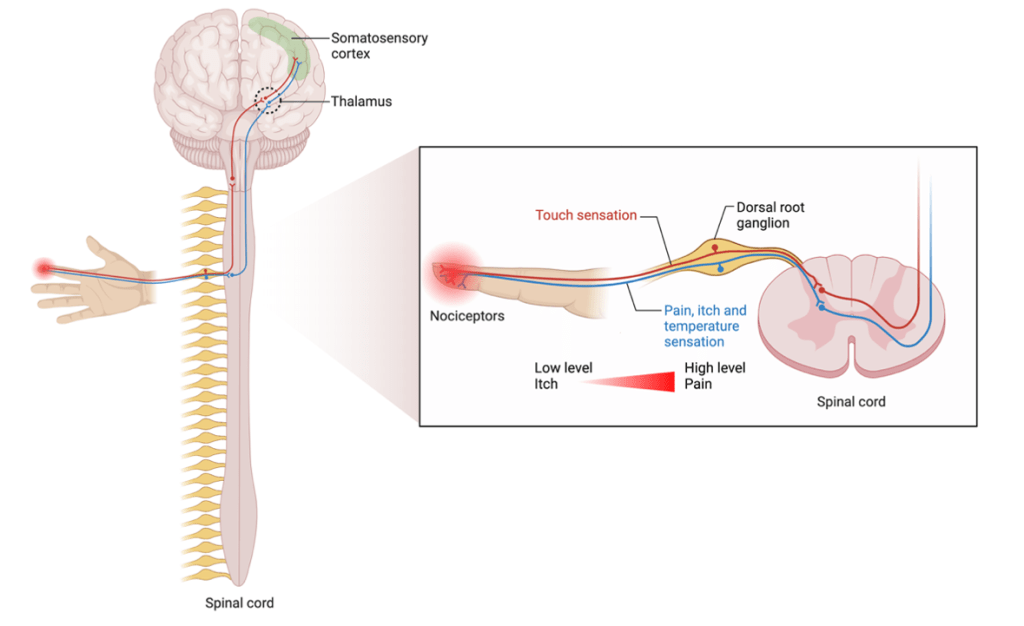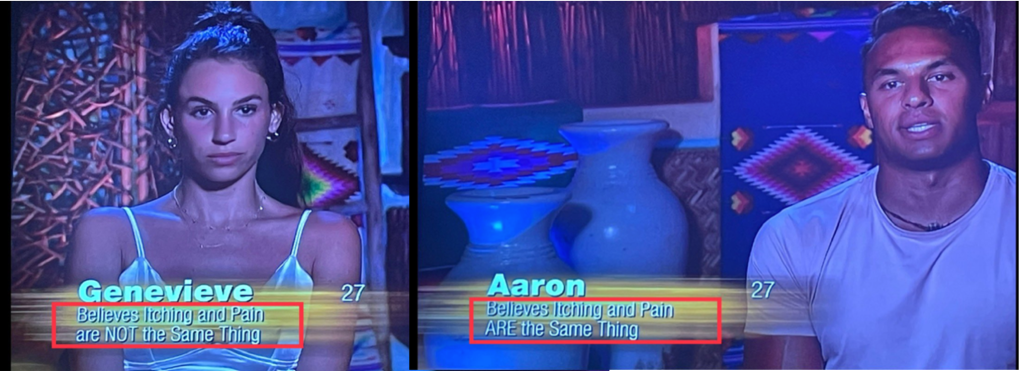By Victoria Vernail
I was sitting on the couch, watching Season 8, episode 14 of ABC’s ‘Bachelor in Paradise’, when an important scientific question was raised. Contestant Aaron commented to his girlfriend Genevieve that he thinks pain and itch are fundamentally the same – to which Genevieve disagreed – and a fight ensued (Figure 1). The consensus from all the couples on the beach that night was that pain and itch are not the same. But what does the scientific literature say about this?
Pain and itch information are both processed through touch, or somatosensory, pathways. These sensations both begin as stimuli at the skin and travel the same pathway to the brain for interpretation and response (Figure 2). In fact, both pain and itch sensations evoke reflexive reactions: either a withdrawal response, like pulling your hand away from a hot stove, or an itch response.

There are specific receptors for touch signals at the skin, including receptors for sensing pain which are called nociceptors. Previously, researchers hypothesized that low-frequency stimulation of nociceptors results in an itch sensation, while high-frequency stimulation results in a pain sensation.1 This mechanism could explain why a wound that was previously painful begins to itch as it heals. An interesting result of this is that prescription pain medications, such as opioids, have been reported to cause itch as a side effect of pain relief.2 Another example of crosstalk between pain and itch sensations occurs with the cycle of itching and scratching. Scratching may relieve itch sensation by promoting a temporary pain response instead, as scratching triggers an increase in inflammation at the skin, and subsequent immune activation in response to tissue damage stimulates pain sensation.3 These examples suggest that pain and itch could oppose one another.
More recent research demonstrates that some nociceptors respond to both pain and itch as distinct sensations rather than variations in frequency. A subtype of these receptors includes the TRPV1 receptor, which has been in the news recently, as its discovery merited the 2021 Nobel prize for Physiology and Medicine. TRPV1 receptors are activated by chemicals that evoke pain responses, such as capsaicin, or chemicals including histamine which triggers itch. Highlighting the relationship between pain and itch, deletion of excitatory TRPV1 receptors in mouse brain cells reduces pain sensitivity but elevated itching behaviors.4 While the sensations of pain and itch share a common pathway and are closely related, more recent research using advanced technology has been able to isolate parts of the two sensations.
The first study to parse out pain and itch uncovered a distinct group of nociceptors that are preferentially activated by itch sensation. To do this, researchers administered histamine to human subjects and isolated the unique response not reproduced by other types of pain stimuli.5 They found that histamine selectively activates a subtype of nociceptors that are only responsive to itch stimuli, which they called pruriceptors. This name is derived from the term pruritus, which isLatin for “itch”.6 This discovery also explained how antihistamines, commonly taken for allergies, reduce the itchy sensation by reducing the activation pruriceptors. Pruriceptors do not signal pain with higher-frequency stimulation like other nociceptors do, making their itch sensation entirely separate from pain sensation. Activation of pruriceptors in mice produces itching behaviors through a unique pathway that does not promote pain sensation, and blocking itch at these receptors does not block pain.7 Subsequent tracing studies have shown that pruriceptors have a unique localization in the spinal cord that does not overlap with pain-responsive cells.8 Despite clinical evidence that pain and itch sensations overlap, the advancement of tools for neuronal tracing and genetic manipulation have shed light on the mechanistic differences between pain and itch. It is possible that there are several types of nociceptors: some that are more general, responding to both pain and itch; and some that are more selective, responding to either pain or itch.
In chronic conditions of pain and itch, the lines between the two sensations become more blurred. This is likely due to the process of sensitization, which leads to an enhanced response to sensory stimulation. In some pathological conditions, such as eczema, the relationship between pain and itch can be disrupted. This disruption leads to an increased itch sensation in response to a painful stimulus.6 it is possible that sensitization is related to increased immune activation, which is seen in both chronic pain and itch, explaining the crossover between the two sensations. The overlap of pain and itch in the context of immune activation could also be seen in feelings such as burning or stinging, which have subjectively been reported to provoke pain or itchiness.
It turns out that the difference between pain and itch was too difficult a scientific question to tackle during a two-hour episode of ‘Bachelor in Paradise’. There is no denying that pain and itch are closely related sensations, but recent work has shown they aren’t entirely the same. Clinically, we can experience pain and itch in similar situations, because some receptors respond to both pain and itch. However, some stimuli (such as histamine) activate itch-specific receptors, eliciting itch sensations separately from pain. Furthermore, there is evidence that communication between pain and itch sensations may be antagonizing. For example, itch receptors are activated by itchy stimuli in a frequency-dependent manner, where a highly itchy stimulus inhibits pain to a greater extent.9 Both pain and itch are important protective sensations that can signal danger to the organism. This could explain the high degree of overlap between the two, but also the need to distinguish pain and itch in certain situations.
TL:DR
- Pain and itch are both protective mechanisms in animals.
- The two sensations are closely related and at times overlap.
- A potential common link between pain and itch is immune activation.
- Some receptors convey both itch and pain sensation using high/low frequency signaling.
- There are itch-specific receptors (pruriceptors) that do not trigger a pain sensation.
References
- Schmelz M. (2010). Itch and pain. Neuroscience and biobehavioral reviews, 34(2), 171–176. https://doi.org/10.1016/j.neubiorev.2008.12.004
- Kumar, K., & Singh, S. I. (2013). Neuraxial opioid-induced pruritus: An update. Journal of anaesthesiology, clinical pharmacology, 29(3), 303–307. https://doi.org/10.4103/0970-9185.117045
- Mack, M. R., & Kim, B. S. (2018). The Itch-Scratch Cycle: A Neuroimmune Perspective. Trends in immunology, 39(12), 980–991. https://doi.org/10.1016/j.it.2018.10.001
- Lagerström, M. C., Rogoz, K., Abrahamsen, B., Persson, E., Reinius, B., Nordenankar, K., Olund, C., Smith, C., Mendez, J. A., Chen, Z. F., Wood, J. N., Wallén-Mackenzie, A., & Kullander, K. (2010). VGLUT2-dependent sensory neurons in the TRPV1 population regulate pain and itch. Neuron, 68(3), 529–542. https://doi.org/10.1016/j.neuron.2010.09.016
- Schmelz, M., Schmidt, R., Bickel, A., Handwerker, H. O., & Torebjörk, H. E. (1997). Specific C-receptors for itch in human skin. The Journal of neuroscience : the official journal of the Society for Neuroscience, 17(20), 8003–8008. https://doi.org/10.1523/JNEUROSCI.17-20-08003.1997
- Liu, T., & Ji, R. R. (2013). New insights into the mechanisms of itch: are pain and itch controlled by distinct mechanisms?. Pflugers Archiv : European journal of physiology, 465(12), 1671–1685. https://doi.org/10.1007/s00424-013-1284-2
- Sharif, B., Ase, A. R., Ribeiro-da-Silva, A., & Séguéla, P. (2020). Differential Coding of Itch and Pain by a Subpopulation of Primary Afferent Neurons. Neuron, 106(6), 940–951.e4. https://doi.org/10.1016/j.neuron.2020.03.021
- Han, L., Ma, C., Liu, Q., Weng, H. J., Cui, Y., Tang, Z., Kim, Y., Nie, H., Qu, L., Patel, K. N., Li, Z., McNeil, B., He, S., Guan, Y., Xiao, B., Lamotte, R. H., & Dong, X. (2013). A subpopulation of nociceptors specifically linked to itch. Nature neuroscience, 16(2), 174–182. https://doi.org/10.1038/nn.3289
- Sun, S., Xu, Q., Guo, C., Guan, Y., Liu, Q., & Dong, X. (2017). Leaky Gate Model: Intensity-Dependent Coding of Pain and Itch in the Spinal Cord. Neuron, 93(4), 840–853.e5. https://doi.org/10.1016/j.neuron.2017.01.012
